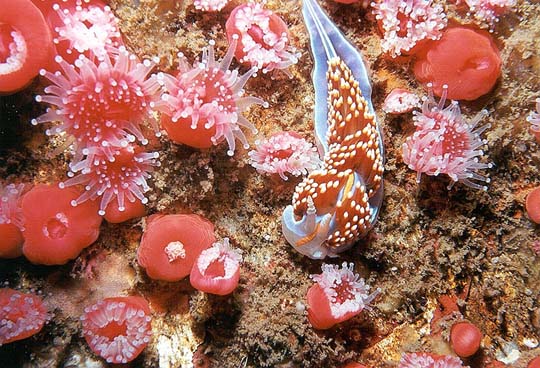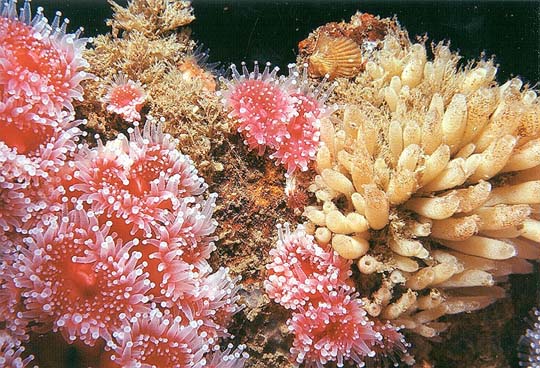
Click on any picture to see a larger image.
Just a couple of miles off the beach at Mission Bay is Wreck Alley. It is an area with a number of artificial reefs including 8 wrecks, a National Oceanographics Communication tower and the Ingrim Street Bridge. This area attracts divers for a number of reasons, but what is probably the main reason they would come back is because the lush, beautiful, colorful life that covers the structures.

The wrecks are mostly a macro world. The life is small and delicate.
The closer the diver looks, the more exotic and colorful life that
they will find.
These different sunken structures make artificial reefs perfectly positioned
in the cold nutrient rich currents. Filter feeders of every sort compete
for room to anchor themselves. Most prevelant are the beautiful
Corynactis californica anemones, also called the Clubbed-
Tipped Anemone or the Strawberry Anemone. There are numerous
other species on the wrecks, including other anemones, scallops,
barnacles, tunicates, zoanthids, crabs, starfish, brittle stars,
nudibranchs and others that a diver can find if they look close.
During the day, some fish of various sizes can be seen around the
wrecks, but
really not many. The wrecks just don't offer much cover to fish. (We
will see about the Yukon) Also with the number of divers visiting
these wrecks, the larger fish tend to make themselves scarce. Still,
you will see small bass, perch, baitfish and whatnot swimming around,
often in groups.
Look close though and you will see various small fish adapted
to living on the wreck itself and in the ecology created by the other
life fixed to the substrate. These fish are usually camoflaged and
have interesting colors and markings
At night, it is a completely different story. The fish that spend
their days searching for food away from the wrecks, come there to
sleep. There are large sheepshead and calico bass. More perch have
come back for the night and in places you can even see white sea bass
tucked into some nook.

Usually , I don't much care
about wrecks. They are usually dead. When I saw the Ruby E the first
time, I couldn't believe my eyes. Its complete covering of
brilliantly colored Corynactis Anemones, made it easily one of the
most beautiful sites I had ever seen under water.
Corynactis anemones are
usually from one, maybe two inches tall and half that across.
Their commonest color is a pinkish, but often you will see variations.
On the wrecks are every color. There were reds, pinks, purples, lavenders,
whites and even some yellow patches. They are called Strawberry Anemones, but
there is every shade of red and pink. The bodies and the tentacles of
the anemones may be different colors as well.
The anemones grow by lateral division, so they tend to grow as
adjacent patches of one colored anemones, with each patch perhaps a
foot square. The entire surface is patches of different vivid colors.
There is some overlap and biologists love to
study the slow motion warfare between the patches.
One of the more exotic and colorful critters you can meet on the wrecks are Nudibranchs. Except for the Spanish Shawl nudibranch though, most of these are rather uncommon, but a close look at these wrecks may reveal a variety of them. The Spanish Shawl with a purple body and orange tentacles protruding from their back, is common on the reefs of California. Those orange tentacles are actually the stinging cells from larger anemones that the Spanish Shawl has injested and caused to grow out of their own back for protection.
There are many other weird looking nudibranchs here as well.
The 366 foot Canadian Destroyer Yukon is the latest addition to Wreck Alley. It was sunk on its port side in about 100 feet of water in late 2000. It is still too new for there to be much growth on it besides some small algaes, but in time it should get the same beautiful covering as the rest of the wrecks. Being larger, it also has the possibility of developing a much larger local fish population and becoming a viable fish nursery. This large boat offers a challenge for tech and wreck divers as well.
The Ruby E is a 170 foot Coast Guard Cutter sunk in about 70 feet of water. It used to be covered from bow to stern with anemones and other thick growths, but visits by so many divers has caused some of the life to disappear. It is still thick and lush around the wheelhouse and along the starboard side of the hull. For a description of a dive there, look at The Ruby E On The Lois Ann
The next largest wreck is the the Del Rey, a kelp cutter. It is less often visited, but well worth it for just that reason.
There are 5 other wrecks that are smaller and well worth visiting by smaller groups, just because they are rarely disturbed and so the life is the most lush.
Another structure that is a bit deeper, but has beautiful encrusting growth is the old National Oceanographics Communication tower.
Another interesting dive in Wreck Alley is the Ingrahm Street Bridge. When Mission Bay was developed and the old bridge was replaced, all it parts were taken out in about 60 feet of water and dumped. It is like diving on a freeway and is quite fascinating. Some areas of the structure that are more in the current, have an encrusting of filter feeders like the wrecks, but much of it is like most natural reefs with kelps, fans and algaes growing over it. Since there is more cover here, there are a lot more fish here than at the wrecks, especially at night. It is a good place to look for lobster in the beginning of the season as well. For a description of a dive there, look at Night Fall With One Eyed Jack
Here are the GPS numbers of some of the structures
Yukon: 117º 17' 12" W by 32º 46' 80" N Ruby E: 117º 16' 36" W by 32º 46' 02" N NOS Tower: 117º 16' 03" W by 32º 46' 21" N El Rey: 117º 16' 36" W by 32º 45' 51" N

Corynactis and Aggregated Nipple Sponge

A beautiful Aggregating Anemone
Click to see an area map of Wreck Alley.
So now that you've seen the place, how do you get there? There are
a number of boats in the area that regularly visit Wreck Alley
including
The Lois Ann or by phone at
619-450-4478.
Another good San Diego Dive boat is
One-Eyed Jack
or
One-Eyed Jack
at 888-420-3047.
Also is Blue Escape
at 888-500-3483.
For even more San Diego Dive Boats, see California Dive Boats at diver.net
There is a lot of other beautiful diving available in San Diego including
Point Loma. There are some nice shore dives from La Jolla Shores
and La Jolla Cove. If you want a dive led by a divemaster, contact
Ocean Enterprises
at 858-565-6064
Enjoy the diving, seahunt
Back To Home Page